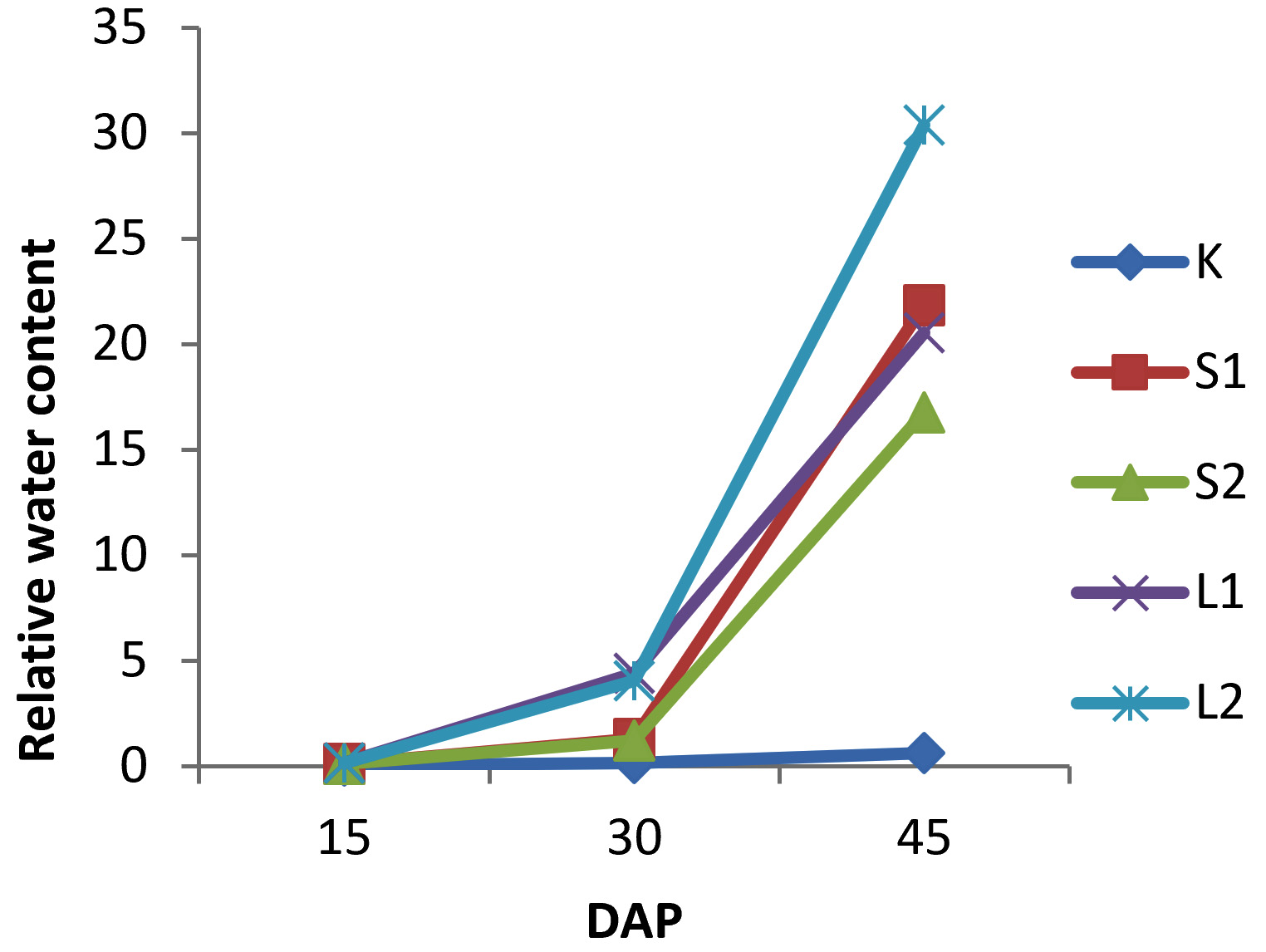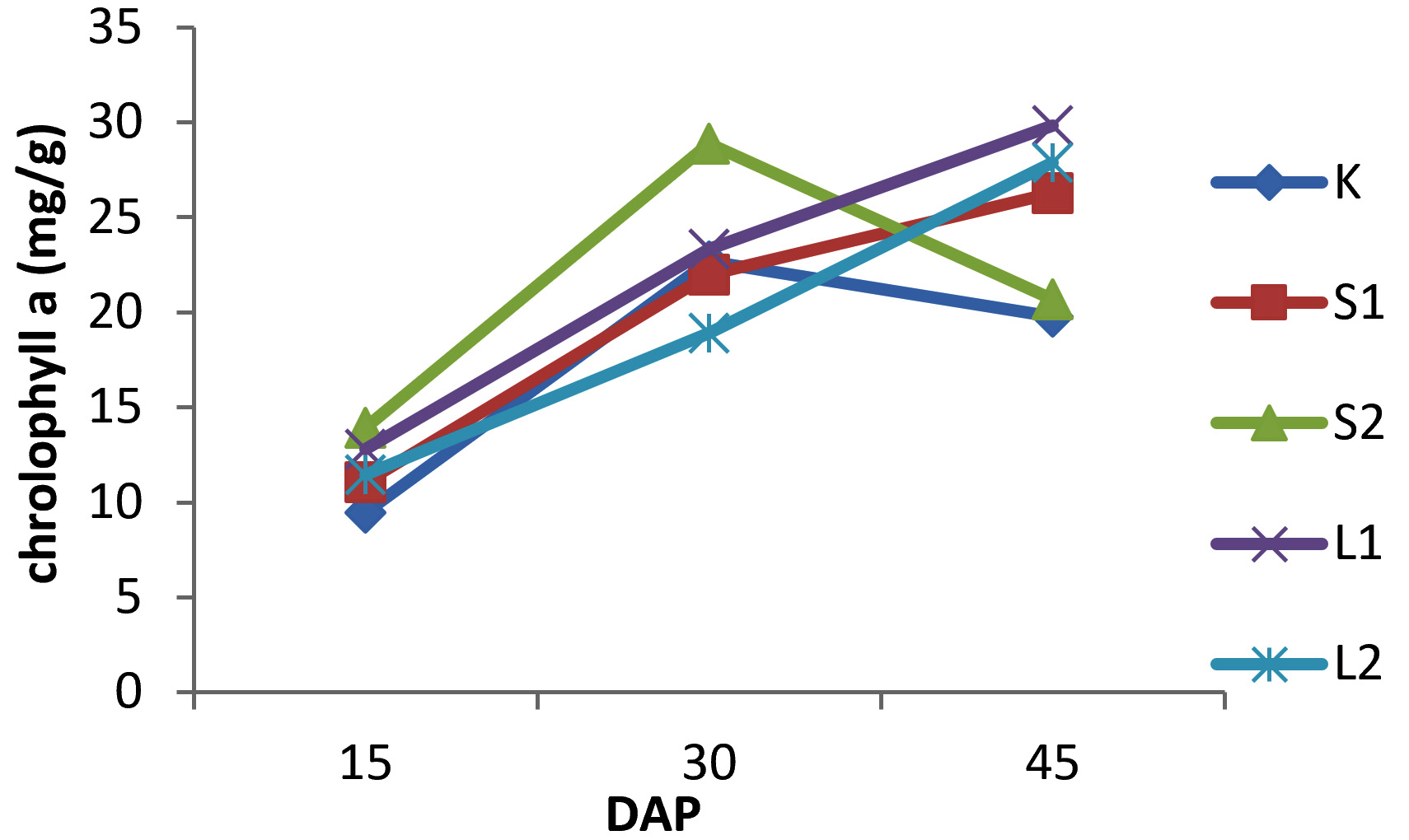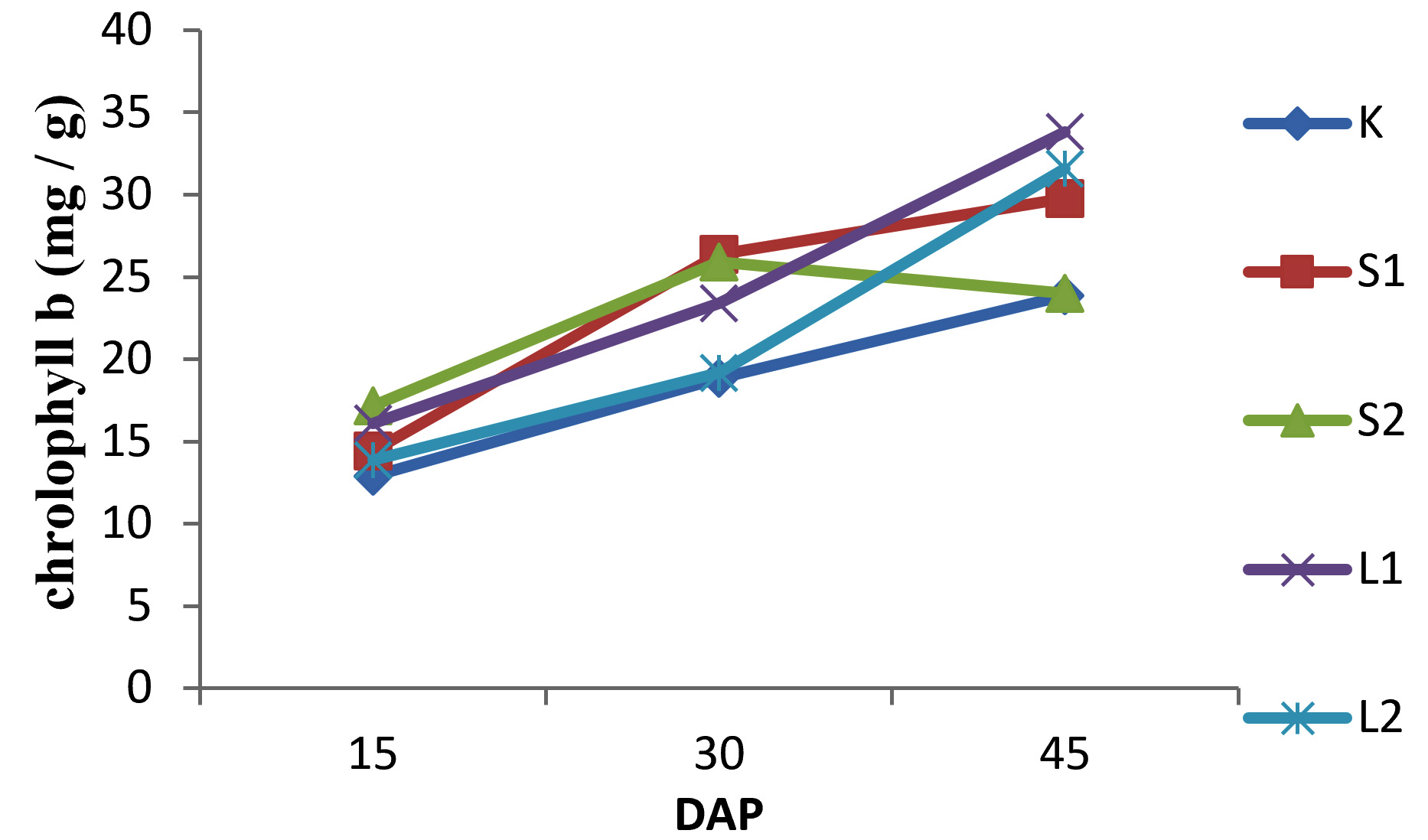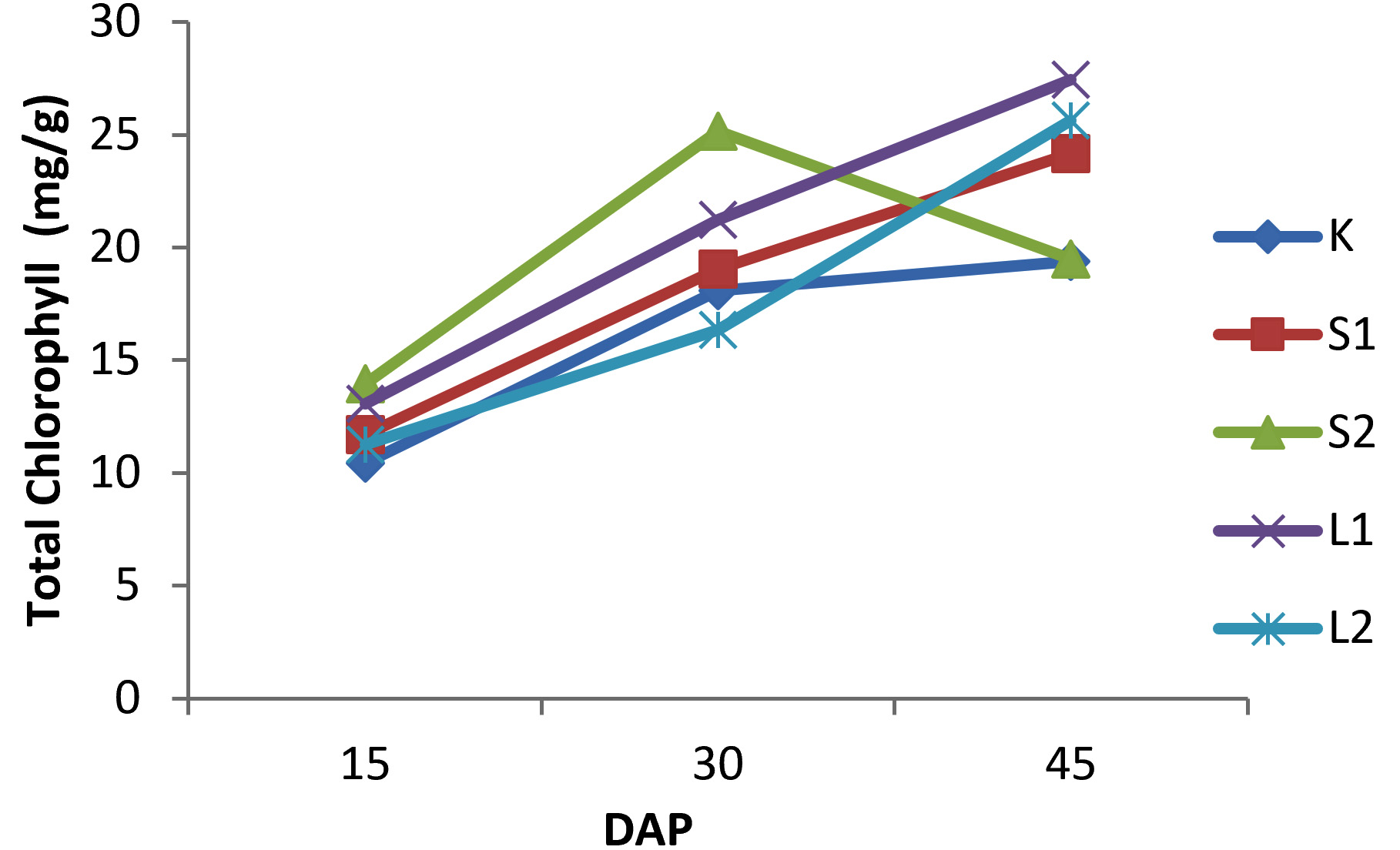ISSN: 0973-7510
E-ISSN: 2581-690X
Green waste (GW) is an important fraction of municipal solid waste (MSW). The composting of lignocellulosic GW is challenging due to its low decomposition rate. Therefore the use of fungi inoculum as a decomposer inducer on GW composting needs to study. The purpose of this study was to explore the potential of the compost induced by cellulolytic (Aspergillus fumigatus) and ligninolytic fungi (Geotrichum sp.) inoculum application on vegetative growth of red chilly plants (Capsicum annuum L.). This research was conducted in the green house of the Faculty of Agriculture the University of Lampung, Indonesia. Completely Randomized Design was adopted with five treatment dose of cellulolytic and ligninolytic compost amandmend of 0%, 10%, and 20% each (K= control, S1= Cellulose 10%, S2= cellulose 20%, L1= Ligninolytic 10% and L2= ligninolytic 20%). Parameters observed were plant height, dry weight, relative water content and chlorophyll of a, b and total. The results demonstrated that compost induced by cellulolytic fungi (Aspergilus fumigatus) and ligninolytic (Geotrichum sp) produced the optimal effect on growth parameters across all treatments. The compost application could increase significantly plant height, dry weight, relative water content. But not the chlorophyll content of a, b and total. The maximum measurements of plant height, dry weight, relative water content was achieved by S2, L2, L2, K and L2 treatments respectively. These results suggest that the inoculum induced compost has bene cial impacts for the use as organic fertilizer to enhance vegetative growth.
Compost, A. fumigatus, Geotrichum sp., vegetative, C. annuum.
Plant requires sufficient nutrients for normal growth. However recently, decreasing soil conditions due to the influence of global climate change and agricultural production makes soil conditions experiencing nutrient deficiencies. As organic agricultural production grows in economic importance, there is an increased need to examine the ef cacy of a variety of plant fertility sources. On the other hand, the growth of urban green areas worldwide has led to an increase of the amounts of green waste (GW) generated. This, in turn, has become an environmental problem in developing and developed countries1. This coincides with efforts in waste reduction, one strategy of which is composting municipal solid waste2. Besides, it increases the need for additional sources of fertilizers. The use of synthetic fertilizers on the soil can cause deterioration to the balance of the soil ecosystem. Fertilization carried out continuously may cause a decrease in the number of soil microorganism population. As a result, the decomposition process in the soil will run very slowly without the help of microfungi as decomposers of organic compounds, and there is a decrease in the process of plant growth and development.
Along with other biowaste (i.e. food waste), GW constitutes the highest fraction of municipal solid waste (MSW)3. One of the compost substrate potential for the future is the use of compost derived from yard litter. In addition, it is to avoide the threat of chemical residual residues using synthetic fertilizers can inhibit plant growth. Compost has been identified as an alternative chemical fertilizer to increase soil fertility and crop production4. Compost is a plant residue, animal residue or a mixture of both that has been decomposed and recycled as a fertilizer and soil amendment. Compost is a key ingredient in organic farming. At its most essential, the process of composting requires simply piling up waste outdoors and waiting a year or more5.
One reesearch has shown that application of selective saprophytic microfungi based on decomposition properties on soil was able to increase soil fertility in the term of Nitrogen, Phosporus and potassium soil content and plant growth of Lycopersicum esculentum Mill6. Based on this, the addition of selected fungi inoculums during the composting process will cause the formation of inoculum enriched compost which is able to accelerate the process of decomposition of organic matter and produces plant nutrients7. One of the subjects that has the potential used as superior organic fertilizer is compost induced by cellulolytic and ligninolytic fungi which enables rapid addition of soil nutrients. Moreover the presence of fungal inoculum in the compost will help the continuous decomposition process in the soil so that it is potential to produce soil fertility nutrients
Compost preparation-Composting using a mixed substrate was carried out using the modified Kumar et al. method8. The litter was dry mixed litter collected from the campus yard with the following mixed of litter: ketepeng (Terminalia catappa), walnuts (Canarium vulgare Leenh), keben (Barringtonia asiatica), Sonokeling (Dalbergia latifolia Roxb.), Jati belanda (Guazuma ulmifolia Lamk.), cantile (Michelia alba) and Puring(Codiaeum variegatum). Litter was used with evenly mixed with amounts of 10 kg each. The litter was mixed, chopped 3-5 cm in size, and aerated dry. The composition of compost materials follows the comparison of Ustuner et al. which is 2: 1 (w / w) for plant vegetation and animal manure9. The compost material used in this study intentionally did not use additional sources of sugar such as molasses because it was intended to suppress the growth of bacteria which would increase the composting temperature which would in fact kill the fungi inoculum.
Cellulolytic fungi (Aspergillus fumigatus) and ligninolytic fungi (Geotrichum sp) were obtained from previous studies. Litter composting process took place in aerobics, medium water content is 30-40%, and the temperature is around 30 – 50°C. A single culture inoculum and a 14-day-old consortium were given as much as 1.0% of the weight of the compost material substrate8. Composting was done using a modification of the Takakura Home Method (THM) method10, 11.
This study was conducted in a completely randomized design experiment with the main factor being fertilization with 5 levels as follows:
1. K = Control
2. S1 = 10% of Cellulolytic compost
3. S2 = 20% of Cellulolytic compost
4. L1 = 10% of Ligninolytic compost
5. L2 = 20% of Ligninolytic compost
The variables of this study were plant height, dry weight, relative water content, and chlorophyll a and b. Fifteen, thirty and forty fife days after planting (DAP), plant parameters were analyzed. Plants were cut 1 cm above the soil surface, then plant fresh weights were recorded, and dry weights were conducted by drying the plants at 60÷C for 24 h. Chili red leaf chlorophyll content was assessed by crushing 1 gram of chili leaves crushed until smooth with mortar, then 20 ml of 96% ethanol was added. The extract is filtered and then put into a test tube. Chlorophyll extract measured the absorbance at wavelengths of 648 and 664 nm. Chlorophyll content was expressed in milligrams per gram (mg / g) of tissue and was calculated in the following equation12:
Chla = 13.36 A664 – 5.19 A648
Chlb= 27.43 A648– 8.12 A664
Data presented in Table 1 show the effect of compost induced by cellulolytic and ligninolytic fungi treatments significantly affected plant height during 15, 30 and 45 day after planting (DAP). However, the highest value of plant height was obtained by the S2 treatment on 45 DAP. No apparent differences were detected on the trait concerning all induced compost treatments beside control.
Table (1):
Plant height (cm) treated by induced compost of cellulolytic and ligninolytic fungi inoculum.
| No | Treatments | 15 DAP | 30 DAP | 45 DAP | |
|---|---|---|---|---|---|
| 1 | K | 4.97 c | 8.57 c | 17.07 d | |
| 2 | S1 | 7.77 b | 19.90 b | 52.70 c | |
| 3 | S2 | 8.60ab | 24.90ab | 66.60 ab | |
| 4 | L1 | 8.90ab | 21.77ab | 59.23 bc | |
| 5 | L2 | 8.30ab | 26.57ab | 60.30 bc | |
Description: – K = control; S1 = Cellulolytic (10%); S2=Cellulolytic (20%); L1 = Ligninolytic (10%); L2 = Ligninolytic (20%). Numbers followed by different letters within columns are significantly different at P < 0.05
Observations of 15 and 30 DAP on plant height show real differences of treatments compared to control, but there were no significance differences among treatments beside control. On the 45 DAP observation the treatment S2 indicated that it was significantly highest amomg all treatments including control. Induced compost had a significant effect on the height of the large red chili plant on all observation days.
Fig. 1 reports the effect of induced compost treatments on the plant height. At 15 DAP the highest chili plants were plants given L1 compost (Ligninolytic 10%). At 30 DAP the highest plants were at L2 (ligninolytic 20%). At 45 DAP the highest plants were achieved at S2 (cellulolytic 20%) compost treatment. Moreover, in the whole compost application, both cellulolytic and ligninolytic gave a good influence compared to controls on the height of large red chili plants.
 Fig. 1. Induced compost effect on the plant height . K = control; S1 = Cellulolytic (10%); S2=Cellulolytic (20%); L1 = Ligninolytic (10%); L2 = Ligninolytic (20%).
Fig. 1. Induced compost effect on the plant height . K = control; S1 = Cellulolytic (10%); S2=Cellulolytic (20%); L1 = Ligninolytic (10%); L2 = Ligninolytic (20%). The results showed that the soils amended with induced compost had a significant effect on the height of chili plants from the three observation times compared to the control. The results comply with Schroth and Sinclair13 stating that plants can grow and develop optimally if the process of absorption of nutrients in large quantities occurs optimally. It is assumed that nutrients available in compost induced by cellulolytic and ligninolytic fungi with a combination of doses of 10% and 20% have been able to meet the needs of large red chili plants so that the growth of plant height can be optimal.
Induced compost stimulated all the plant growth parameters through the improvement effect on the meristematic activity of tissues, where these compost are rich in N, P, K and other minerals which are required for propellant growth. As a result of these prospects, it may be concluded that compost improved the structure of sandy soil and consequently encouraged the plant to achieve good growth. Moreover, the slow released nutrients from compost permit the plants to get benefit of them, and thus improved plant growth5. Several studies have been done related to organic amendments on improving soil physical, chemical, and biological properties, providing essential plant nutrients to stimulate plant growth and yield14-17.
Table 2 presented the effect of compost induced by cellulolytic and ligninolytic fungi on the dry weight of large red chili plants. Treatments significantly affected dry weight of plants during 15, 30 and 45 DAP. Observations of 15 and 30 DAP on dry weight show significant differences of treatments compared to control, but there were no significance differences among treatments (exclude control). On the 30 DAP the highest dry weight value was achieved by L1 . On the 45 DAP observation the treatment L2 indicated that it was significantly highest among all treatments including control.
Table (2):
Dry weight of plants (g) treated by induced compost of cellulolytic and ligninolytic fungi inoculum.
No |
Treatments |
15 DAP |
30 DAP |
45 DAP |
|---|---|---|---|---|
1 |
K |
0.002 d |
0.041b |
0.124 f |
2 |
S1 |
0.010 bcd |
0.152 b |
5.081cde |
3 |
S2 |
0.021ab |
0.103 b |
4.091de |
4 |
L1 |
0.011 bcd |
0.427a |
3.175 e |
5 |
L2 |
0.013 bcd |
0.420a |
5.789 bcd |
Description: – K = control; S1 = Cellulolytic (10%); S2=Cellulolytic (20%); L1 = Ligninolytic (10%); L2 = Ligninolytic (20%). Numbers followed by different letters within columns are significantly different at P < 0.05
Fig. 2 reports the effect of induced compost treatments on the dry weight of the plant. On the 45 DAP chili plants that had the highest dry weight value were plants given L2 compost (ligninolytic 20%) treatments. Moreover, overall fertilizer application, both cellulolytic, and ligninolytic compost gave a good effect compared to the control on the dry weight of large red chili plants.
 Fig. 2. Induced compost effect on the dry weight. K = control; S1 = Cellulolytic (10%); S2=Cellulolytic (20%); L1 = Ligninolytic (10%); L2 = Ligninolytic (20%).
Fig. 2. Induced compost effect on the dry weight. K = control; S1 = Cellulolytic (10%); S2=Cellulolytic (20%); L1 = Ligninolytic (10%); L2 = Ligninolytic (20%). The data also indicated that the induced compost affects the dry weight of large red chili plants. The existence of a significant effect is thought to be due to the adequacy of plant nutrients provided by induced compost fertilizer. The addition of compost can improve soil quality as well as providing nutrients for plants, so that it is good for plant growth. The application of GW compost is very promising because of the physicochemical diversity of the material so that the strategy of adding a consortium of fungi inoculums greatly help the decomposition process18. The compost contains several macro and micro-nutrients that can improve soil physical, chemical, and biological properties, providing essential plant nutrients to stimulate plant growth and yield15-17.
Table 3 shows that induced compost application had a significant effect on the relative moisture content of large red chili plants on observation days except on the 15 DAP. Observations of 30 and 45 DAP on relative moisture content show significant differences of treatments. On the 30 DAP the highest relative moisture content value was achieved by L1. On the 45 DAP observation the treatment L2 indicated that it was significantly highest among all treatments.
Table (3):
Relative moisture content of plants (g). treated by induced compost of cellulolytic and ligninolytic fungi inoculum.
| No | Treatments | 15 DAP | 30 D AP | 45 DAP | |
|---|---|---|---|---|---|
| 1 | K | 0.05a | 0.15 c | 0.63 d | |
| 2 | S1 | 0.13a | 1.28 abc | 21.87 bcd | |
| 3 | S2 | 0.10a | 1.20 bc | 16.77 cd | |
| 4 | L1 | 0.15a | 4.41ab | 20.57 bcd | |
| 5 | L2 | 0.14a | 4.06ab | 30.39abc | |
Description: – K = control; S1 = Cellulolytic (10%); S2=Cellulolytic (20%); L1 = Ligninolytic (10%); L2 = Ligninolytic (20%). Numbers followed by different letters within columns are significantly different at P < 0.05
Fig 3. reports the effect of induced compost treatments on the relative moisture content of the plants. On the 15, 30 and 45 DAP the plants that have the highest relative water content were plants given compost L2 (ligninolytic 20%).
 Fig. 3. Induced compost effect on the relative moisture content. K = control; S1 = Cellulolytic (10%); S2=Cellulolytic (20%); L1 = Ligninolytic (10%); L2 = Ligninolytic (20%).
Fig. 3. Induced compost effect on the relative moisture content. K = control; S1 = Cellulolytic (10%); S2=Cellulolytic (20%); L1 = Ligninolytic (10%); L2 = Ligninolytic (20%).The relative water content of a large red chili plant has increased over time. The water content of plants is resulted fromabsorption of plant roots and with the addition of compost can increase the absorption of roots of nutrients so that it can increase water content of plants. This is in accordance with Sepwanti et al.19 stated that fungi-induced compost (Trichoderma harzianum) can increase the growth of red chili plants including the fresh weight and moisture content of a plant.
Fig. 4 reports that the effect of compost induced by cellulolytic and ligninolytic fungi on the leaf chlorophyll a of the leaves on 15 DAP, 30 DAP, and 45 DAP indicated no significant difference of all treatments. On the 15 and 30 DAP the highest effect of induced compost on chlorophyll a content was on S2 (cellulolytic 20%), whereas on the 45 DAP the highest chlorophyll a content was on L1 (ligninolytic 10%). Fig. 5 shows the effect of compost induced by cellulolytic and ligninolytic fungi on the leaf chlorophyll b content. The applications indicate that there were no significant difference of all treatments.
 Fig. 4. Induced compost effect on chlorophyll a of the leaves. K = control; S1 = Cellulolytic (10%); S2=Cellulolytic (20%); L1 = Ligninolytic (10%); L2 = Ligninolytic (20%).
Fig. 4. Induced compost effect on chlorophyll a of the leaves. K = control; S1 = Cellulolytic (10%); S2=Cellulolytic (20%); L1 = Ligninolytic (10%); L2 = Ligninolytic (20%). On the 15 and 30 DAP the highest effect of induced compost on leaf chlorophyll b content was on S2 (cellulolytic 20%), and on the 45 DAP highest leaf chlorophyll b content was at L1 (ligninolytic 10%). However, the overall treatment of compost addition gave the best effect compared to the control on chlorophyll b of large red chili leaves (Fig. 5).
 Fig. 5. Induced compost effect on chlorophyll b content. K = control; S1 = Cellulolytic (10%); S2=Cellulolytic (20%); L1 = Ligninolytic (10%); L2 = Ligninolytic (20%).
Fig. 5. Induced compost effect on chlorophyll b content. K = control; S1 = Cellulolytic (10%); S2=Cellulolytic (20%); L1 = Ligninolytic (10%); L2 = Ligninolytic (20%). There were no significant differences in total chlorophyll content among treatments. However, induced compost led to an increase in total chlorophyll content in plant tissues more than control except when plant treated with S2 which tend to decrease on 45 DAP (Fig. 6)
 Fig. 6. Induced compost effect on total chlorophyll content. K = control; S1 = Cellulolytic (10%); S2=Cellulolytic (20%); L1 = Ligninolytic (10%); L2 = Ligninolytic (20%).
Fig. 6. Induced compost effect on total chlorophyll content. K = control; S1 = Cellulolytic (10%); S2=Cellulolytic (20%); L1 = Ligninolytic (10%); L2 = Ligninolytic (20%). The results indicate that the compost treaments did not have a significant effect on the chlorophyll a, b and total. Although the compost treatment has no significant effect on chlorophyll content but there is a tendency that treatments can increase the chlorophyll content in large red chili plants.
The application of compost induced cellulolytic fungi (Aspergillus fumigatus) and ligninolytic (Geotrichum sp) can increase vegetative growth of large red chili plants (Capsicum annuum L.) including plant height, dry weight, relative water content, but no significant for chlorophyll a, b, and total.
Acknowledgements
The authors thank to Institute for Research and Community Services, Universitas Lampung that provided fund for this research to be undertaken through Leading Research Scheme (Penelitian Unggulan) 2017. PT. Great Giant Pineapple, Terbanggi Besar, Central Lampung, Indonesia for providing pineapple biomass for composting.
Conflict Of Interest
The authors declare that there is no conflict of interest.
Authors’ Contribution
All authors have made substantial, direct and intellectual contribution to the work and approved it for publication.
Funding
Leading Research Scheme (Penelitian Unggulan) 2017 Universitas Lampung, with contract no. 808/UN26.21/PP/2017, July 27, 2017.
Data Availability
All datasets generated or analyzed during this study are included in the manuscript.
Ethics Statement
This article does not contain any studies with human participants or animals performed by any of the authors.
- Zhang L., Sun X. Addition of seaweed and bentonite accelerates the two-stage composting of green waste. Bioresou. Technol., 2017; 233: 116–126.
- Radin A.M., Warman P.R. Assessment of Productivity and Plant Nutrition of Brussels Sprouts Using Municipal Solid Waste Compost and Compost Tea as Fertility Amendments. Int. J. Vegetable Sci., 2010; 16: 374-391.
- Kumar M., Ou Y.L., Lin J.G. Co-composting of green waste and food waste at low C/N ratio. Waste Manage., 2010; 30 (4): 602–609.
- Asgharipour M.R., Armin M. Growth and Elemental Accumulation of Tomato Seedlings Grown in Composted Solid. Am-Euras J. Sustain. Agr., 2010; 4(1): 94–101.
- Mazhar A.A.M., Abdel-Aziz N.G., Shedeed S.I., Zaghloul S.M. Effect of Nile Compost Application on Growth and Chemical Constituents of Jatropha Curcas Grown under Different Salinity Levels of Diluted Sea Water. Aus. J. Basic Appl. Sci., 2011; 5(9): 967–974.
- Irawan B., Afandi Hadi S. Effects of Saprophytic Microfungi Application on Soil Fertility Based on Their Decomposition Properties. J. Appl. Biol. Sci., 2017; 11(2): 15–19.
- Irawan B., Kasiamdari R.S., Sunarminto B.H., Sutariningsih. Preparation of Fungal Inoculum for Leaf Litter. ARPN J. Agr. Biol. Sci., 2014; 9(3): 7–10.
- Kumar A., Gaind S., Nain L. Evaluation of Thermophilic Fungal Consortium for Paddy Straw Composting. Biodegradation, 2008; 19: 395-402.
- Ustuner O., Wininger S., Gadkar V., Badani H., Raviv M., Dudai N., Medina S., Kapulnik Y. Evaluation of Different Compost Amendments with AM Fungal Inoculum for Optimal Growth of Chieves. Compost. Sci. Util., 2009; 17(4): 257-265.
- Ying G.H., Chi L.S., Ibrahim M.H. Changes of Microbial Biota during the Biostabilization of Cafeteria Wastes by Takakura Home Method (THM) Using Three Different Fermented Food Products.UMT 11th International Annual Symposium on Sustainability Science and Management 09th – 11th July 2012, Terengganu, Malaysia, 2012, 1408-1413.
- Kitakyushu International Techno-Cooperative Association. Separation at Source, Collection and Composting of Waste in Surabaya, Indonesia: Promoting the Reduction and Recycling of Waste.Report Project 2004-2006. Environmental Restoration and Conservation Agency, Japan Fund for Global Environment Promotional Activity, 2007.
- Miazek K., Ledakowicz S. Chlorophyll Extraction from Leaves , Needles and Microalgae/ : A Kinetic Approach. Int. J. Agr. Biol. Eng., 2013; 6(2): 107-115.
- Schroth G., Sinclair F.L. Impacts of trees on the fertility of agricultural soils, 2003, pp. 1–12. In: Schroth G, Sinclair FL (Eds) Trees, crops and soil fertility. Concepts and research methods. CABI Publishing, Wallingford.
- Liu M., Hu F., Chen X., Huang Q., Jiao J., Zhang B., Li H. Organic amendments with reduced chemical fertilizer promote soil microbial development and nutrient availability in a subtropical paddy field: the influence of quantity, type and application time of organic amendments. Appl. Soil Eco., 2009; 42: 166–175.
- Yu H.Y., Ding W.X., Luo J.F., Donnison A., Zhang J.B. Long- term effect of compost and inorganic fertilizer on activities of carbon-cycle enzymes in aggregates of an intensively cultivated sandy loam. Soil Use Manage, 2012; 28: 347–360.
- Cavagnaro T.R. Impacts of compost application on the formation and functioning of arbuscular mycorrhizas. Soil Biol. Biochem., 2014; 78: 38–44.
- Xie H., Li J., Zhu P., Peng C., Wang J., He H., Zhang X. Long-term manure amendments enhance neutral sugar accumulation in bulk soil and particulate organic matter in a Mollisol. Soil Biol. Biochem., 2014; 78: 45–53.
- Reyes-Torres M., Oviedo-Ocaסa .ER., Dominguez I., Komilis D., Sבnchez A. A systematic review on the composting of green waste: Feedstock quality and optimization strategies. Waste Manage, 2018; 77: 486-499.
- Sepwanti C., Rahmawati M., Kesumawati E. The effect of Variety and compost dosage enriched by Trichoderma harzianum towards the growth and harvest yield red chili (Capsicum annuum L.). J Kawista, 2016; 1(1): 68-74. (in Indonesian).
© The Author(s) 2019. Open Access. This article is distributed under the terms of the Creative Commons Attribution 4.0 International License which permits unrestricted use, sharing, distribution, and reproduction in any medium, provided you give appropriate credit to the original author(s) and the source, provide a link to the Creative Commons license, and indicate if changes were made.


